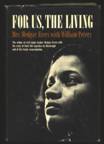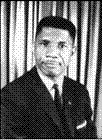 For
Us, The Living
For
Us, The Living For
Us, The Living
For
Us, The Living
By Mrs. Medgar Evers with William Peters,
Doubleday
and Company, Garden City, NY, 1967, 378 pages (Reprinted 1996,
University Press of Mississippi)
Review by Hans Sherrer (December 2001)
One of the most shameful legacies of this country’s legal system is its attitude toward, and prejudicial treatment of people of color. That mistreatment was evident from the South’s institutionalized racism and segregation laws. Continuing into the 1960’s, the mere accusation that an African-American committed a crime against a white person, especially a woman, was often enough to trigger the person’s beating or murder at the hands of a legally protected white mob. With a wink and a nod from the police, prosecutors, judges and politicians, literally thousands of Black’s were given the short shrift justice of a lynch mob’s rope.
One man who refused to turn a blind eye to the injustices of racism was Medgar Evers. Born in 1925 and raised in Mississippi, his experiences inflamed his passion against racism to the core of his soul. He was so disturbed by it that he dedicated his adult life to trying to alleviate its causes and eradicate its ugly consequences.
In For Us, The Living, his widow Myrlie Evers paints a
portrait of Medgar Evers, her life with him before and after their
marriage in 1951, and their central role in the rise of the modern
civil rights movement. As Mrs. Evers writes: “Until I met
Medgar, I had never heard a Negro challenge segregation. Now I was
married to a man who did, openly and publicly.” (131-132)
Mr. Evers’ fervent and courageous quest led him in 1954 to become the first black to apply for admission to the University of Mississippi Law School, which denied him entry in spite of his qualifications. It continued during the many years he headed the NAACP in Mississippi, beginning in 1954 when he opened that organization’s first office in the state, with Myrlie Evers as his secretary. It ended with his assassination in 1963 at the age of 37.
Silencing Medgar Evers and others who opposed the structure of injustice imposed on blacks was an obsession of those who benefited from that system. Among the many dangers Mr. Evers and his fellow crusaders faced was being subject to Mississippi justice: framed for a crime and wrongly convicted and imprisoned or executed.
As an example of that all too real danger, Mrs. Evers relates the sad tale of Clyde Kennard. (219-223). Unable to be dissuaded from applying for admission to Mississippi Southern College in 1960, he was framed for the burglary of several bags of chicken feed from a warehouse. Wrongly convicted at the prime of his young life, he was sentenced to seven years in prison. Clyde Kennard’s health started deteriorating after he was imprisoned. Kennard died in 1963, a few months after public pressure induced Mississippi’s governor to suspend his sentence.
[Picture of Clyde Kennard]
Mississippi judges not only enabled innocent black people to be routinely convicted, but they effectively operated a protection racket for white racists. After the acquittal of a white man for the shooting death of a young black man he described as a “smart alec,” Mrs. Evers quotes from a mid-1950s newspaper editorial: “...no matter how strong the evidence nor how flagrant is the apparent crime, a white man cannot be convicted in Mississippi for killing a Negro.” (183).
A rigid court system, unending psychological intimidation, and the ever present threat of physical violence didn’t deter Medgar Evers from mobilizing, educating, and inspiring blacks and poor whites in Mississippi and throughout the South to stand up for their rights. He continued doing so until the night of June 12, 1963, when his wife Myrlie found him lying in the driveway of their home drenched in blood and dying from a gunshot wound in his back.
A vocal redneck racist, Byron De La Beckwith, was indicted for Mr. Evers’ murder. Although his fingerprints were on the murder weapon, in 1964 two all white juries were unable to reach a verdict on Beckwith’s guilt or innocence. New evidence caused the case to be reopened 30 years later. Remarried in 1976, Mrs. Evers-Williams played a key part in Beckwith’s 1994 conviction of murdering Medgar Evers. A measure of the changes in Mississippi that Mr. Evers was instrumental in instigating is indicated by that jury’s composition of 4 white people and 8 black people.
Thirty years-old at the time of her husband’s murder, Myrlie Evers moved to California with her two children. In 1969 she graduated from Pomona College. She became a successful business executive, a Public Works commissioner in Los Angeles, and she remarried. In 1995 she was elected chairwoman of the board of the NAACP.
For Us, The Living transcends being an autobiographical account of Myrlie Evers’ life with her husband. It is a deeply moving first person account of the personal sacrifices that anyone who seeks to effect a societal change must expect to endure. People of color in Mississippi can now freely vote, serve on juries, they don’t have to sit at the back of the bus, and they can eat at the same lunch counter with whites ... because of the efforts of people like Medgar Evers.
Considering the depth of his passion and commitment, there is little doubt that if Medgar Evers was alive today he would be speaking out against the prevalence of racial profiling, the disproportionate arrest, conviction and harsh sentencing of the politically powerless, and the astronomical growth of the law enforcement networks presence in this country.
Given the propensity for police and prosecutors to enmesh innocent people in the nightmare of a criminal prosecution, the much greater number of prosecutions today means there significantly more cases of injustice today than when Medgar Evers was alive. For us, the living, the pursuit of fair treatment for all goes on.
Above all else, For Us, The Living is an ode to the mutual courage and loyalty of Medgar and Myrlie Evers in the face of incredible adversity, and the love they shared. Whether read as a love story or a tale of committed people struggling against an entrenched and powerful opponent to achieve social justice, For Us, The Living has lost none of its relevance or punch in the four decades since its publication.
For Us, The Living was reprinted in 1996 by the University Press of Mississippi, and that edition is available from Justice Denied’s Bookshop at, http://justicedenied.org/books.htm
The picture on the cover of the 1967 edition of For Us, The Living was Medgar Evers favorite picture of his wife Myrlie. This review was written in December 2001.